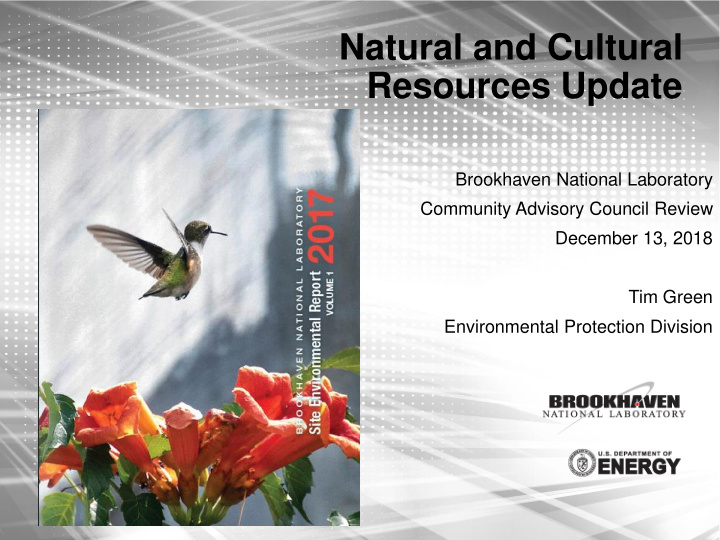



Natural and Cultural Resources Update Brookhaven National Laboratory Community Advisory Council Review December 13, 2018 Tim Green Environmental Protection Division
Agenda • 2017 SER Chapter 6 • Cultural Resources Update • Natural Resources Update 2
Chapter 6 - Natural and Cultural Resources ▪ Natural Resource Management ▪ Deer Management ▪ March cull removed 202 deer ▪ End of year population ~ 300 ▪ (3) successful Prescribed Fires ▪ Turkey population at ~500 ▪ Continued opportunities for interns looking at a variety of ecological topics (a little more on this later) Comparison of Cs-137 Average Concentrations in Deer ▪ Surveillance Monitoring – Deer Meat (2017), line is ten year average 0.83 pCi/g for onsite and near off-site samples ▪ 2 on site, 16 off site samples ▪ Cs-137 in deer had similar results as past years - highest value 3.33 pCi/g, wet weight, off-site along WFP. ▪ Ten-year trend shows decline; 2017 on-site average in meat was 1.25 pCi/g, wet weight, with ten year on-site average being 0.83 pCi/g, wet weight ▪ Average value from deer cull (41 samples) sampling was 0.26 pCi/g, wet weight. Well below BNL administrative limit of 1.0 pCi/g, wet weight Ten-Year Trend of Cs-137 Concentrations in Deer Meat, dashed line is pre-cleanup avg., solid line is 10- year avg.
Chapter 6 - Flora and Fauna Monitoring (continued) ▪ Fish surveillance monitoring ▪ Peconic River Dry – no fish monitoring ▪ Peconic River Clean-up ▪ Final 2600 sq. ft. area cleaned up
Chapter 6 - Flora and Fauna Monitoring (continued) ▪ Terrestrial vegetation and soils ▪ Grassy vegetation and soils similar to past years ▪ High Cs-137 values in both vegetation and soils at FHWMF, values below clean-up standards ▪ 10.00 pCi/g wet weight – vegetation ▪ 10.08 pCi/g dry weight - soils ▪ Basin Sediments ▪ Sampled on a 5-year rotation ▪ Non-detect to 0.08 pCi/g Cs-137 ▪ Low levels of PCBs, DDT, and DDE ▪ No Semi-VOCs ▪ Precipitation monitoring ▪ Low level mercury – highest value 45.1 ng/L ▪ Previous high 24.6 ng/L recorded in 2013 5
Chapter 6 – Wildlife Programs ▪ Internships ▪ 17 Undergraduate Interns ▪ 2 Faculty Members (Hofstra and SUNO) ▪ Projects ▪ Eastern box turtles ▪ Small mammals and ticks ▪ Prescribed fire – fuels monitoring, pre- and post- fire monitoring, fire effects monitoring ▪ Data analysis – bird survey data ▪ Pollinator studies 6
Chapter 6 – Wildlife Programs ▪ MOU w/SUNY Environmental Science and Forestry ▪ Agreement to develop research opportunities ▪ Initial discussions and planning for first round of research initiated (more in 2018 update) ▪ Southern Pine Beetle ▪ Tracking and suppression efforts 7
Chapter 6 - Cultural Resource Management ▪ 70 YEARS OF Discovery – A CENTURY OF SERVICE ▪ Summer Sundays – History of BNL Site 70 th Anniversary Celebration ▪ ▪ Multiple speaking opportunities ▪ Loan of Camp Upton collection to local museum Dedication of 100 th Anniversary plague ▪ at flag pole
2018 Cultural Resource - Update 100 th Anniversary – God Bless ▪ America ▪ Recordation of 1960s era apartments ▪ Evaluation of WW I era concrete roads ▪ Determined “not eligible” for listing on National Register 9
2018 Natural Resource - Update ▪ MOU between BNL and SUNY-ESF ▪ January meeting – research needs for Long Island Pine Barrens ▪ May – Proposal Reviews – Forest Health selected ▪ Planning for implementation summer 2019 ▪ Eastern box turtles ▪ Master’s student successfully defended – dietary study 1 st manuscript in review now - ▪ Freeze tolerance study – temperature logger implants removed – data being reviewed ▪ Home range studies – all field work completed - Data now has to be analyzed 10
Natural Resource - Update ▪ Pollinator studies ▪ Interns from Southern University New Orleans established three-year study of LISF - Established protocols - Collected baseline data ▪ Vegetation monitoring ▪ Forest health plots ▪ Deer exclosures ▪ Prescribed Fire ▪ Single prescribed fire June 2018 ˗ MOU w/NYSDEC Forest Rangers ▪ Fire Effects monitoring 2017 prescribed fires (next slides) 11
Prescribed Burn conducted June 12, 2017 Fuels monitoring conducted pre- and post-burn. Overall, fuels were reduced from 11 tons/acre to 3.7 tons/acre – a reduction of ~69%.
Fire Effects Monitoring • Did the burn do what we wanted it to do? • Monitor overall burn severity – i.e. the magnitude of ecological change caused by the fire and spatial heterogeneity (patchiness) of the burn. • Amount and types of fuels consumed American burnweed • Regeneration of existing species • Establishment of new species • Delayed mortality Pink Lady’s slipper orchid Pennsylvania sedge
Prescribed Burn conducted June 12, 2017 10/03/18 09:18
Natural Resource - Update ▪ 4 – Poster ▪ Continued deployment - 80% reduction in ticks where deployed - 64,500 lbs. of corn over 31 weeks - Last year 71,450 lbs. of corn over 28 weeks ▪ New experiment at request of NYSDEC deer biologist - Effectiveness of reduced servicing - 3-year experiment 15
QUESTIONS? 16
Recommend
More recommend